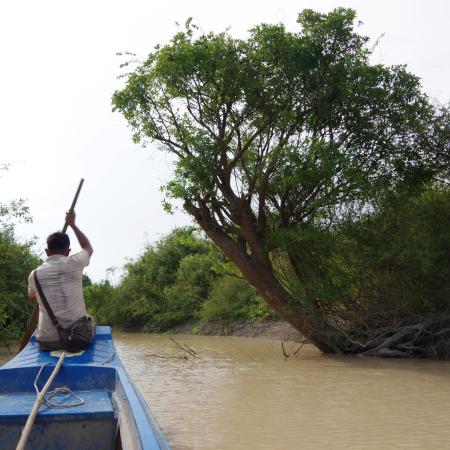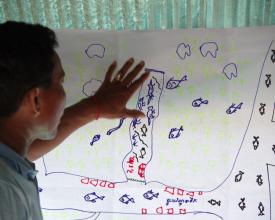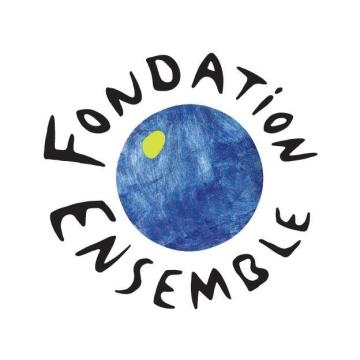Fomento de la capacidad comunitaria para gestionar la pesca de agua dulce en Camboya

Camboya alberga una de las mayores pesquerías continentales del mundo. Centrada en torno al lago Tonle Sap y el río Mekong, la pesca proporciona alimentos y medios de subsistencia a millones de personas. Gran parte de este recurso común es gestionado por Organizaciones Pesqueras Comunitarias (CFi's) - pescadores locales con un mandato gubernamental que gestionan su área local en beneficio de sus recursos pesqueros. Por desgracia, los pescadores camboyanos son algunos de los más pobres y marginados del país. Y la mayoría de los CFi de Camboya son disfuncionales. Establecer CFi funcionales requiere un importante desarrollo de la capacidad comunitaria, ya que las CFi se enfrentan a problemas de registro gubernamental, capacidad organizativa, conocimientos financieros, planificación y ejecución. El enfoque de desarrollo de la capacidad comunitaria de Conservación Internacional aborda estos problemas y nos hemos asociado con éxito con catorce CFI que gestionan activamente sus recursos pesqueros locales.
Contexto
Défis à relever
Como la mayoría de las organizaciones pesqueras comunitarias de Camboya carecen de recursos suficientes, no pueden gestionar adecuadamente sus recursos pesqueros locales. Entre sus problemas figuran la destrucción de bosques y matorrales inundados para la agricultura y por incendios provocados deliberadamente, así como la pesca ilegal y excesiva. El cambio climático y el desarrollo hidroeléctrico aguas arriba están alterando los regímenes de caudales naturales, lo que supone una amenaza aún mayor para la pesca. El cambio climático también está provocando estaciones secas más largas y calurosas y estaciones húmedas más cortas pero más intensas. La mayoría de las comunidades lacustres tienen poca o ninguna capacidad para gestionar sus recursos naturales o adaptarse a estos cambios, que están degradando constantemente sus medios de subsistencia.
Ubicación
Procesar
Resumen del proceso
Los cuatro bloques son complementarios. Bloque 1: el análisis DAFO y el análisis de situación determinan las comunidades adecuadas y revelan información sobre la que se basan los bloques posteriores. Bloque 2 - El enlace con el Gobierno interactúa con el Bloque 1, ya que el apoyo de las autoridades locales es fundamental para el éxito a largo plazo de la CFi. La capacidad se construye sobre estos dos bloques a través del Bloque 3 - mapeo de recursos comunitarios y el Bloque 4 - formación del Comité de CFi. Estos bloques proporcionan a los CFi los conocimientos estructurados y las habilidades necesarias para gestionar con éxito sus recursos pesqueros.
Bloques de construcción
Enlace con el Gobierno
Dado que las pesquerías comunitarias operan bajo un mandato gubernamental, la participación de las autoridades locales -especialmente el cantón de la administración pesquera y los funcionarios de la comuna local- es fundamental para el éxito de cualquier compromiso con una IPC. Las autoridades locales deben comprender y apoyar el compromiso de Conservación Internacional con una ICP. En primer lugar, nos reunimos con la Administración Pesquera a nivel nacional y local para presentar nuestro programa e identificar las CFI potencialmente adecuadas. En estas reuniones establecemos relaciones con altos funcionarios del gobierno y obtenemos información como, por ejemplo, contactos locales dentro de las posibles CFI. Una vez establecido el apoyo a alto nivel, nos ponemos en contacto con las autoridades locales, como los ayuntamientos, y al informarles de nuestro planteamiento nos hacemos una idea de la situación actual, los retos y las oportunidades de cada CFI.
Factores facilitadores
Establecer el apoyo de los altos funcionarios del gobierno es un primer paso esencial. A continuación, se requiere la participación de las autoridades locales, que intervienen en el proceso de planificación y otorgan reconocimiento oficial a los documentos legales relacionados con el desarrollo de la CFi. Lo ideal es que el equipo de ejecución pueda aprovechar los vínculos establecidos con las autoridades locales pertinentes. Sin embargo, deben comprender el contexto en el que operan estas autoridades locales y cómo nuestras actividades de desarrollo de CFi mejoran las funciones y responsabilidades de las autoridades locales. Este proceso debe ser llevado a cabo por personal senior del proyecto con experiencia en relaciones gubernamentales.
Lección aprendida
El compromiso temprano con las autoridades locales es importante, ya que su participación es crucial para el éxito de cualquier compromiso con una CFI. También proporcionarán al equipo del proyecto información adicional sobre la capacidad de la CFI y aumentarán la probabilidad de éxito de la colaboración con una CFI.
Análisis DAFO, de situación y de vulnerabilidad climática
Un análisis de la situación proporciona información de fondo sobre la que se basan los esfuerzos de capacitación de la comunidad. En primer lugar, realizamos un rápido análisis DAFO de una pesquería comunitaria (PPC) y su comunidad asociada. El análisis DAFO recopila información básica sobre cada comunidad y examina la estructura y el funcionamiento de la CFi. Las fortalezas, debilidades, oportunidades y amenazas a las que se enfrenta cada comunidad se abordan en un debate de grupo entre el equipo de implementación y un pequeño número de representantes de la comunidad. El análisis de la vulnerabilidad climática permite hacerse una idea de los problemas específicos que plantea el cambio climático en cada comunidad, en particular los relacionados con sus ZEC.
Utilizamos el análisis DAFO para determinar si una comunidad es apta para una mayor implicación y, en caso afirmativo, realizamos un análisis de situación detallado que profundiza en las características y los retos de una CFi. Esto nos permite decidir si nos asociamos con una comunidad y, en caso afirmativo, los resultados nos ayudan a desarrollar un enfoque adecuado para trabajar con ellos. El análisis de la situación también se utiliza para determinar la participación de las mujeres en la pesca comunitaria: a partir de esta información, aumentamos su participación a medida que ponemos en marcha otros componentes básicos. El Análisis de Vulnerabilidad Climática es el primer paso de nuestra amplia colaboración con una comunidad.
Factores facilitadores
El equipo de ejecución debe estar familiarizado con el contexto pesquero de la comunidad y formado para realizar el análisis DAFO y de situación. También es necesario generar confianza con la comunidad.
Lección aprendida
Las decisiones importantes se toman en tres pasos: 1) decidir qué comunidades evaluar inicialmente y realizar un análisis DAFO; 2) utilizar los resultados del análisis DAFO para dar prioridad a las comunidades que se evaluarán más a fondo mediante el análisis de situación completo; y 3) utilizar los resultados del análisis de situación para decidir con qué comunidades asociarse para el desarrollo de capacidades y la aplicación del análisis de vulnerabilidad climática.
Recursos
Cartografía de los recursos comunitarios
La creación conjunta de un mapa de recursos naturales y activos comunitarios prepara el terreno para el desarrollo de las capacidades comunitarias. Un mapa de recursos comunitarios representa tanto las características naturales (por ejemplo, arroyos, estanques, arrozales, etc.) como la infraestructura física. A través del mapa de recursos aprendemos cómo los aldeanos gestionan, conservan y utilizan sus recursos naturales. El mapa de recursos de la comunidad debe ser elaborado por al menos 10 miembros de la comunidad bien informados, entre ellos miembros del comité de gestión de CFi y de CFi, mujeres, ancianos y autoridades locales. Con la ayuda del equipo del proyecto, un miembro bien informado de la comunidad redacta el mapa. Antes de ser representada, la ubicación de las características importantes debe ser discutida y confirmada por otros participantes. El mapa también debe representar las zonas oficiales (por ejemplo, zonas de pesca comunitarias o zonas de conservación de peces comunitarias) o debatir las posibles zonas de zonificación.
Una vez terminado el mapa, se celebra un debate en grupo para determinar la dependencia y la interacción de la población con sus recursos naturales, así como los principales problemas de gestión y conservación. Esto permite encontrar áreas de mejora en el desarrollo comunitario, la gestión de los recursos naturales y la conservación.
Factores facilitadores
Se necesita una comunidad adecuadamente motivada para elaborar un mapa de recursos comunitarios preciso e informativo. El equipo del proyecto necesita experiencia en la facilitación de debates de grupos comunitarios y en la elaboración de mapas de recursos comunitarios. El equipo también debe asegurarse de que las mujeres participen en los debates y de que las reuniones se celebren a horas adecuadas que les permitan asistir.
Lección aprendida
El reto más común al que se enfrentan las comunidades pesqueras es la gestión de sus refugios para peces en la estación seca. Muchos de estos estanques están desconectados del lago en la estación seca y corren el riesgo de secarse a medida que el cambio climático prolongue las condiciones de calor en la estación seca. Nuestros socios comunitarios han sugerido aumentar la profundidad de estos humedales y crear conexiones permanentes con el lago para garantizar que permanezcan llenos durante la estación seca y proteger así a los peces que allí se refugian hasta que el lago vuelva a inundarse. Otro reto al que se enfrentan muchas comunidades es la dificultad de gestionar zonas de conservación remotas. Esto suele dar lugar a la creación de nuevas zonas de conservación más cercanas a las aldeas locales, lo que permite una gestión más cercana y eficaz.
Formación del Comité de Pesca Comunitario
La gestión de la pesca comunitaria es compleja y cada comité de CFi debe convocar y registrar reuniones, celebrar elecciones y ser transparente y responsable desde el punto de vista financiero. Los comités también necesitan competencias para trabajar con las autoridades locales y comprender el marco jurídico en el que operan. Para ello, impartimos módulos de formación sobre procedimiento de reuniones, gestión de comités, legislación pesquera, cuestiones de género en la gestión de recursos naturales, protección del medio ambiente, redacción de propuestas e informes y gestión presupuestaria.
Factores facilitadores
El Comité de CFi debe estar debidamente estructurado y activo antes de que pueda recibir formación sobre procedimiento de reuniones, gestión de comités, Ley de Pesca, género en la GRN, protección del medio ambiente, redacción de propuestas e informes y gestión financiera. Los formadores deben tener experiencia en la formación de aldeanos locales y en los materiales de formación. El equipo del proyecto debe garantizar que las mujeres participen en los debates y que las reuniones se celebren a horas adecuadas para que puedan asistir.
Lección aprendida
Aumentar la capacidad de gestión de los comités de pesca comunitarios no sólo les ayuda a gestionar sus recursos pesqueros, sino que también genera confianza entre sus miembros, los donantes, las autoridades locales y la administración pesquera. Nuestra formación ha dado a los comités de pesca comunitaria la capacidad de presentar su trabajo a simpatizantes y funcionarios municipales y de la administración pesquera. Los comités CFi son ahora capaces de alinear sus planes de trabajo con la estrategia de inversión de su comuna. La formación sobre género en la GRN ha mejorado la igualdad entre hombres y mujeres en el acceso y la gestión de sus recursos naturales.
Impactos
Hemos aplicado nuestro enfoque a catorce Organizaciones Pesqueras Comunitarias de Camboya. Cada CFi está reconocida por el Gobierno Real de Camboya y sus comités activos están aplicando sus planes de gestión. El desarrollo de la capacidad de estas organizaciones ha beneficiado directamente a los 7.347 miembros de las catorce CFi (incluidas 3.856 mujeres). Mientras tanto, 43.470 ha de hábitat piscícola, incluidas aguas abiertas, bosques inundados y matorrales, arrozales y estanques refugio para peces de temporada seca, están bajo gestión comunitaria. Esto ha permitido a nuestras comunidades asociadas gestionar de forma coherente sus CFi realizando patrullas para detectar actividades pesqueras ilegales -a menudo junto con funcionarios de la Administración Pesquera-, protegiendo las 24 horas del día sus estanques de refugio para peces durante la estación seca, respondiendo a la amenaza de incendios forestales e impartiendo sesiones educativas tanto a los miembros de las CFi como a los pescadores estacionales sobre sus derechos y responsabilidades según la Ley de Pesca. Nuestras comunidades asociadas también han empezado a restaurar más de 500 hectáreas de bosque inundado. También han forjado fuertes lazos con las autoridades locales y de distrito.
Beneficiarios
Los miembros de las organizaciones pesqueras comunitarias y sus familias se benefician de una mejor gestión de la pesca. Se conservan unas 300 especies de peces y su hábitat en las llanuras aluviales, así como numerosas aves, mamíferos y reptiles amenazados por la Lista Roja de la UICN.
Objetivos de Desarrollo Sostenible
Historia

Cuando Conservation International empezó a trabajar con las comunidades pesqueras del lago Tonle Sap en 2010, los aldeanos se preguntaron cómo afectaría nuestro trabajo de conservación al acceso a la pesca. A través de numerosas reuniones discutimos nuestros objetivos de conservación y cómo podrían ayudar a sus medios de subsistencia. Llevar a cabo un análisis de la situación de nuestra solución nos permite comprender sus circunstancias, que seguimos con una amplia formación y capacitación. Gracias a ello, estas comunidades vieron los beneficios del trabajo de conservación y han cambiado sus prácticas para proteger sus recursos.
Por ejemplo, cuando empezamos a trabajar con la pesquería comunitaria de Srey Chek (CFi) en 2015, su comité de gestión de CFi estaba inactivo y los miembros de la comunidad nos dijeron que sus recursos pesqueros estaban en declive debido a la sobreexplotación y a la pesca ilegal desenfrenada en su zona de CFi. Gracias a la aplicación de las medidas descritas en esta solución, el CFi de Srey Chek cuenta con un comité de gestión fuerte y comprometido que recibe el apoyo de los miembros del CFi y de las autoridades locales, desde el pueblo hasta el nivel provincial. Este apoyo implica la participación activa en las actividades y la financiación del CFi. El Comité de CFi patrulla ahora regularmente su zona de CFi, a menudo acompañado por funcionarios de la Administración de Pesca y autoridades locales que están legalmente autorizados a advertir o multar a los pescadores ilegales y a retirar los aparejos de pesca ilegales. Los miembros del Comité CFi de Srey Chek no sólo protegen su zona comunitaria de conservación de peces, sino que también ayudan a la Administración de Pesca a vigilar el cercano santuario estatal de peces, denunciando las actividades ilegales directamente al Gobernador Provincial. El Comité CFi también ha liberado peces, como el barbo gigante(Catlocarpio siamensis), en peligro crítico, y animales salvajes, como pitones y tortugas, recibidos de los miembros del CFi y las autoridades locales, en su zona comunitaria de conservación de peces.







